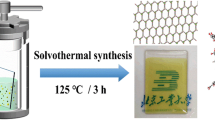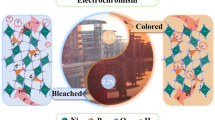Abstract
Transition metal oxides (TMOs) with switchable optical properties have been attracting huge attention in the scientific community due to their potential application. In this work, we present a new approach to synthesize and stabilize the titanium dioxide (TiO2) using polyol synthesis. The electrochromic properties of anatase TiO2 thin films deposited by dip coating on flexible substrate, from as-synthesized powder, are studied. To enhanced the electrochromic properties of the TiO2, we recently developed a new strategy based on the addition of poly(3,4-ethylenedioxythiophene)-poly(styrenesulfonate) (PEDOT: PSS) leading to TiO2 + PEDOT:PSS hybrid composites film. TiO2 + PEDOT:PSS films exhibit improved electrochromic performance in terms of durability, nice color change between dark-blue and white transparent, fast switching time, and coloration efficiency compared to single-component TiO2. To conclude, an flexible electrochromic device combining two electrochromic composite film–based (TiO2 + PEDOT:PSS), via a lithium-based electrolyte membrane plastified with PMMA, was successfully built. The electrochromic characterizations showed that the flexible hybrid composite device switches reversibly from a dark blue to white transparent in the less than 1 s associated with a high in situ transmittance modulation (∆T = 70%) at 750 nm.















Similar content being viewed by others
References
Miura N, Nishimura M, Urano H (2008) Organic electrochromism for a new color electronic paper. Sol Energy Mater Sol Cells 92:136–139. https://doi.org/10.1016/j.solmat.2007.02.027
Kim G, Hong S, Yoo S, Park J (2021) Solution-processed all-solid-state electrochromic devices based on SnO2/NiO doped with tin. Coatings 11:1431. https://doi.org/10.3390/coatings11111431
Granqvist CG, Arvizu MA, Pehlivan IB, Qu H.-Y, Wen RT, Niklasson GA (2018) Electrochromic materials and devices for energy efficiency and human comfort in buildings: a critical review. Electrochim Acta 259:1170–1182 https://doi.org/10.1016/j.electacta.2017.11.169
Nunes D, Freire T, Barranger A, Vieira J, Matias M, Pereira S, Pimentel A, Cordeiro NJA, Fortunato E, Martins R (2020) TiO2 nanostructured films for electrochromic paper based-devices. Appl. Sci 10:1200 https://doi.org/10.3390/app10041200
Keersmaecker MD, Lang AW, Österholm AM, Reynolds JR (2018) All polymer solution processed electrochromic devices: a future without indium tin oxide? ACS Appl Mater Interfaces 10:31568–31579. https://doi.org/10.1021/acsami.8b10589
Guo Q, Li J, Zhang B, Wang GND (2019) High-performance asymmetric electrochromic-supercapacitor device based on poly(indole-6-carboxylicacid)/TiO2 nanocomposites. ACS Appl Mater Interfaces 11(6):6491–6501. https://doi.org/10.1021/acsami.8b19505
Barawi M, De Trizio L, Giannuzzi R, Veramonti G, Manna L, Manca M (2017) Dual band electrochromic devices based on Nb-doped TiO2 nanocrystalline electrodes. ACS Nano 11(4):3576–3584. https://doi.org/10.1021/acsnano.6b06664
Berger S, Ghicov A, Nah Y-C, Schmuki P (2009) Transparent TiO2 nanotube electrodes via thin layer anodization: fabrication and use in electrochromic devices. Langmuir 25(9):4841–4844. https://doi.org/10.1021/la9004399
Cai G, Tu J, Zhou D, Li L, Zhang J, Wang X, Gu C (2014) Constructed TiO2/NiO core/shell nanorod array for efficient electrochromic application. J Phys Chem C 118(13):6690–6696. https://doi.org/10.1021/jp500699u
Wang J-L, Sheng S-Z, He Z, Wang R, Pan Z, Zhao H-Y, Liu J-W, Yu S-H (2021) Self-powered flexible electrochromic smart window. Nano Lett 21(23):9976–9982. https://doi.org/10.1021/acs.nanolett.1c03438
Xiong C, Aliev AE, Gnade B, Balkus KJ Jr (2008) Fabrication of silver vanadium oxide and V2O5 nanowires for electrochromics. ACS Nano 2(2):293–301. https://doi.org/10.1021/nn700261c
Yun TG, Park M, Kim D-H, Kim D, Cheong JY, Bae JG, Han SM, Kim I-D (2019) All-transparent stretchable electrochromic supercapacitor wearable patch device. ACS Nano 13(3):3141–3150. https://doi.org/10.1021/acsnano.8b08560
Li H, McRae L, Elezzabi AY (2018) Solution-processed interfacial PEDOT:PSS assembly into porous tungsten molybdenum oxide nanocomposite films for electrochromic applications. ACS Appl Mater Interfaces 10(12):10520–10527. https://doi.org/10.1021/acsami.7b18310
Zilberberg K, Gharbi H, Behrendt A, Trost S, Riedl T (2012) Low-temperature, solution-processed MoOx for efficient and stable organic solar cells. ACS Appl Mater Interfaces 4(3):1164–1168. https://doi.org/10.1021/am201825t
Kiristi M (2014) Ferhat Bozduman, Aysegul Uygun Oksuz, Lutfi Oksuz, Ahmed Hala, Solid state electrochromic devices of plasma modified WO3 hybrids. Ind Eng Chem Res 53(41):15917–15922. https://doi.org/10.1021/ie5025613
Ravi R, Surendren S, Deb B (2021) Studies on all-solid electrochromic devices fabricated by a bilayered assembly of hydrated vanadium pentoxide and PEDOT:PSS coatings. Surfaces and Interfaces 22:100860. https://doi.org/10.1016/j.surfin.2020.100860
Dahlman CJ, Heo S, Zhang Y, Reimnitz LC, He D, Tang M, Milliron DJ (2021) Dynamics of lithium insertion in electrochromic titanium dioxide nanocrystal ensembles. J Am Chem Soc 143(22):8278–8294. https://doi.org/10.1021/jacs.0c10628
Park K-W (2005) Influence of Pt nanocrystallinity on electrochromism of TiO2. Inorg Chem 44(9):3190–3193. https://doi.org/10.1021/ic049021a
Li R, Ma X, Li J, Cao J, Hongze Gao, Tianshu Li, Xiaoyu Zhang, Lichao Wang, Qinghong Zhang, Gang Wang, Chengyi Hou, Yaogang Li, Tomás Palacios ,Yuxuan Lin, Hongzhi Wang, Xi Ling (2021) Flexible and high-performance electrochromic devices enabled by self-assembled 2D TiO2/MXene heterostructures. Nat Commun 12:1587 https://doi.org/10.1038/s41467-021-21852-7
Eyovge C, Deenen CS, Ruiz-Zepeda F, Bartling S, Smirnov Y, Morales-Masis M, Susarrey-Arce A, Gardeniers H (2021) Color tuning of electrochromic TiO2 nanofibrous layers loaded with metal and metal oxide nanoparticles for smart colored windows. ACS Appl Nano Mater 4(8):8600–8610. https://doi.org/10.1021/acsanm.1c02231
Kawahara J (2012) Peter Andersson Ersman, Isak Engquist, Magnus Berggren, Improving the color switch contrast in PEDOT:PSS-based electrochromic displays. Org Electron 13:469–474. https://doi.org/10.1016/j.orgel.2011.12.007
Gomes L, Branco A, Moreira T, Feliciano F, Pinheiro C (2016) CláudiaCosta, Increasing the electrical conductivity of electrochromic PEDOT:PSS films — a comparative study. Sol Energy Mater Sol Cells 144:631–640. https://doi.org/10.1016/j.solmat.2015.10.001
Singh R, Tharion J, Murugan S, Kumar A (2017) ITO-free solution-processed flexible electrochromic devices based on PEDOT:PSS as transparent conducting electrode. ACS Appl Mater Interfaces 9(23):19427–19435. https://doi.org/10.1021/acsami.6b09476
Author information
Authors and Affiliations
Corresponding author
Additional information
Publisher’s note
Springer Nature remains neutral with regard to jurisdictional claims in published maps and institutional affiliations.
Rights and permissions
About this article
Cite this article
Almarri, A.H. Enhanced electrochromic properties of anatase TiO2 for flexible electrochromic device. Ionics 28, 4435–4444 (2022). https://doi.org/10.1007/s11581-022-04646-9
Received:
Accepted:
Published:
Issue Date:
DOI: https://doi.org/10.1007/s11581-022-04646-9




